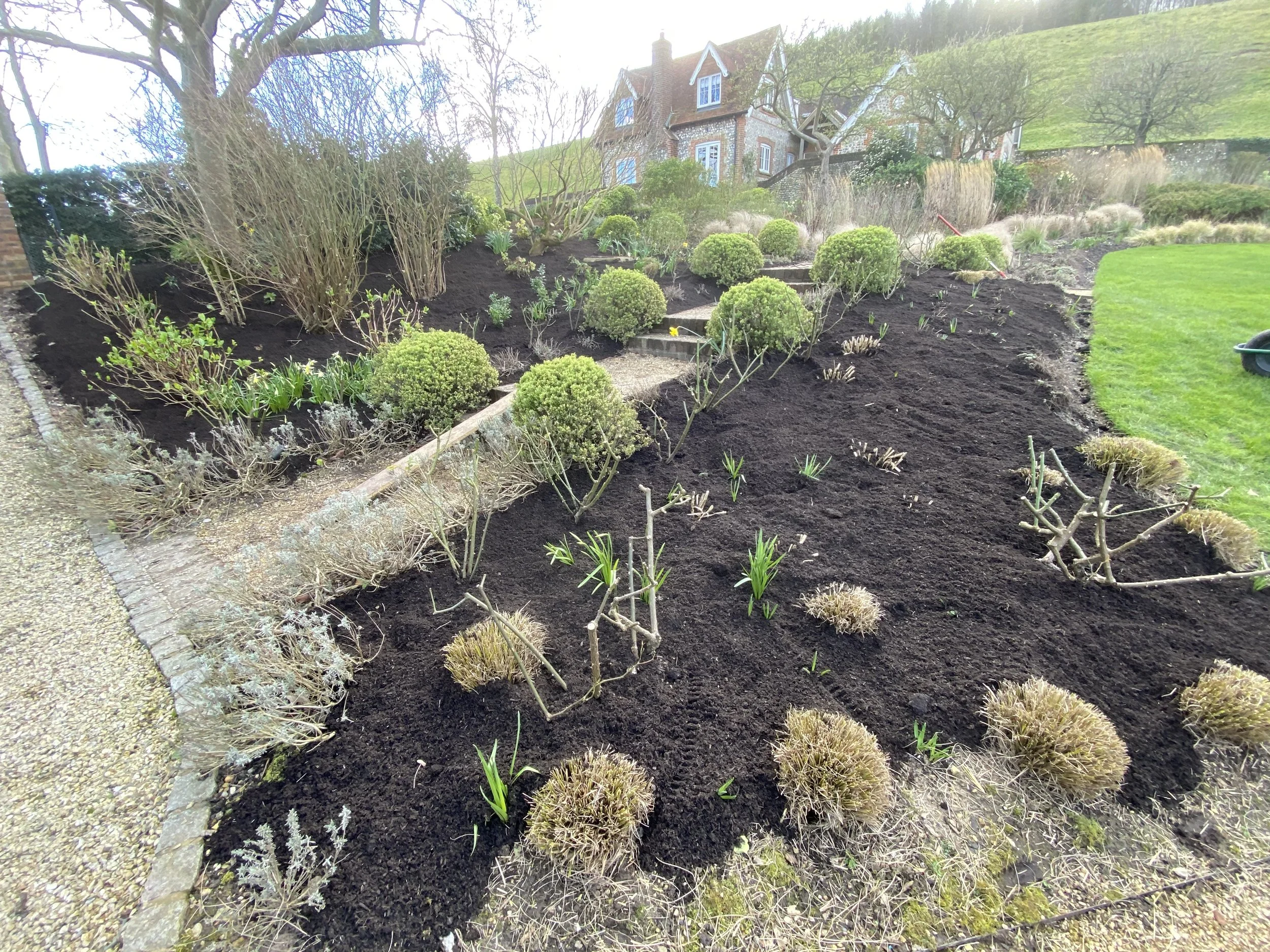The Ultimate Guide to Pruning Shrub and Floribunda Roses
Pruning is one of the most essential aspects of maintaining healthy, vibrant roses in your garden. Whether you're caring for shrub roses or floribundas, a well-timed prune can encourage new growth, improve the overall shape of the plant, and enhance flower production. In this guide, we’ll walk through how to properly prune both shrub and floribunda roses to keep them looking their best year after year.
Why Prune Roses?
Pruning is not just about keeping your roses looking tidy. It serves several important purposes:
Encourages Healthy Growth: Pruning helps remove dead or diseased wood, promoting the flow of nutrients to healthier parts of the plant.
Shapes the Plant: It helps maintain a desirable shape, preventing roses from becoming too leggy or overgrown.
Increases Flowering: Regular pruning stimulates new growth, which means more flowers throughout the growing season.
Below is an image of the garden when the roses are pruned in winter and a video of how this area is pruned
When to Prune Roses
Timing is crucial when it comes to pruning roses. Pruning at the wrong time can damage the plant and reduce flowering. Here's a general guide:
For Shrub Roses: These roses are generally hardy and can handle a more flexible pruning schedule. The best time to prune is in late winter or early spring, just as new buds begin to swell but before the new growth begins. You can also give them a light pruning in the fall, removing dead or diseased wood.
For Floribunda Roses: Floribundas bloom profusely and benefit from a good pruning to shape the plant and enhance their flowering potential. Like shrub roses, floribundas should be pruned in late winter or early spring, before the plant starts producing new growth. Deadheading (removing spent flowers) can be done throughout the growing season to encourage more blooms.
How to Prune Shrub Roses
Shrub roses can vary in size and form, but the basic principles of pruning remain similar. Here’s a step-by-step guide for pruning shrub roses:
1. Prepare Your Tools
Before you start, make sure your pruning tools are sharp and clean. You’ll need:
Pruning shears or secateurs for small stems
Loppers for thicker branches
Gloves to protect your hands from thorns
Disinfectant to clean tools between cuts (especially if you’re pruning diseased branches)
2. Remove Dead or Diseased Wood
Start by cutting out any dead, damaged, or diseased wood. These parts of the plant are often discolored or shriveled, and cutting them away helps prevent disease from spreading.
3. Shape the Plant
Look at the overall shape of the shrub. Shrub roses typically benefit from a lighter, more natural shape. Cut back any overly long or awkward stems to create a rounded, balanced form. Focus on removing any inward-growing stems that can crowd the center of the plant.
4. Cut Back Old Growth
Cut the plant back by about a third of its total size. This will stimulate new, vigorous growth. Always cut just above a bud facing outward so the new growth will develop in an outward direction, allowing the plant to stay open and airy.
5. Thin Out the Plant
Remove any old or weak stems to allow more air and light to reach the center of the plant. This helps improve air circulation and reduces the risk of fungal diseases.
Same area of the garden as the first image. Video Below
How to Prune Floribunda Roses
Floribunda roses are known for their compact, bushy growth and continuous bloom cycle. Pruning floribundas is about encouraging healthy new growth and maintaining a neat, attractive appearance.
1. Prepare Your Tools
As with shrub roses, start by ensuring that your pruning tools are clean and sharp. A good pair of pruning shears should be sufficient for most cuts.
2. Remove Dead or Weak Wood
Begin by cutting out any dead or damaged wood. Floribunda roses tend to have multiple stems, so be sure to remove any weak or spindly growth that doesn’t look healthy.
3. Cut Back to a Strong Bud
Floribundas bloom on both old and new wood, so you can prune back harder than you might with other roses. Make your cuts just above a strong, outward-facing bud. This will encourage a branching habit and help the plant produce more flowers.
4. Trim for Shape
Cut back any overly long canes and trim the bush to maintain a nice, compact shape. Floribundas don’t need to be as heavily pruned as hybrid teas, but they still benefit from regular shaping to prevent the plant from becoming too leggy.
5. Deadheading
Throughout the blooming season, make sure to remove spent flowers (deadheading) to encourage continuous blooming. Simply cut back to the first healthy leaf or bud below the faded flower.
Common Pruning Mistakes to Avoid
Even experienced gardeners can make pruning mistakes. Here are a few to watch out for:
Pruning Too Early or Late: Pruning too early can encourage new growth that’s susceptible to late frosts, while pruning too late can cut off potential buds for the next season.
Over-pruning: While it's tempting to cut a plant back too much, over-pruning can stress the rose and reduce flowering. Aim to remove no more than a third of the plant's overall size at once.
Leaving Jagged Cuts: Always make clean cuts to reduce the risk of disease and encourage faster healing.
Pruning the Wrong Wood: Be sure to know which type of rose you have (whether it's a repeat bloomer or one that blooms only on old wood) before cutting back heavily. Floribundas bloom on both old and new wood, so you can prune them more severely than other types.
Aftercare Post-Pruning
Once you’ve pruned your roses, there are a few additional steps to ensure they stay healthy:
Watering: Give your roses a deep watering to help them recover from the pruning process.
Fertilizing: After pruning, apply a balanced rose fertilizer to support new growth. I use organic feed. Pot ash or Blood, Fish and Bone.
Mulching: Add a layer of mulch around the base of the plant to retain moisture and suppress weeds.
Conclusion
Pruning shrub and floribunda roses is a rewarding task that can significantly enhance the health, shape, and beauty of your plants. Whether you're shaping a shrub rose into a more natural form or keeping a floribunda bush tidy for a bountiful bloom, regular pruning is key. Just remember to prune at the right time, use sharp tools, and avoid over-pruning. With the right care, your roses will reward you with gorgeous blooms season after season!
Happy pruning, and here's to a garden full of stunning roses! 🌹
How to prune shurb roses. A video here in how to do so.




